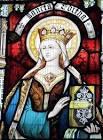
Feast day: 18 September
St Edith of Wilton was the only daughter of Edgar the Peaceful (959-975) and St Wulfthryth, who later became abbess of Wilton Abbey. Edith is an interesting saint, because she seemed to be able to combine her royal status and its concerns with the asceticism of a Benedictine monastery. There seems to be some doubt about the relationship of her parents. Apparently Edgar took the noblewoman Wulfthryth from the convent at Wilton and either kept her as a concubine or else married her. However, the union was dissolved and Wulfthryth returned to her convent with Edith. Edgar nonetheless continued to take an interest in his daughter, arranging her education with two foreign chaplains, Radbod of Rheims and Benno of Trier.
There is a controversy over whether Edith was actually a nun or a secular member of the community. Her main biographer, writing about a hundred years after her death, was a Flemish Benedictine monk who came to England and wrote lives of the saints. He relates that her father Edgar came to the convent and placed before her the finest clothes and jewels, while her mother put religious objects. Edith opted for the religious life, though she always wore fine clothes - the Bishop of Winchester admonished her for this but she replied: “My father, the mind may be modest and God-fearing under fine clothes as under a serge habit. The God I love looks to the heart and not to the dress.” According to legend, she was vindicated when a chest caught fire as a candle was accidentally dropped on it; the clothes remained untouched. The chest was preserved in the convent. She also seemed to have been free to indulge her interest in animals, as she kept a menagerie of native and exotic creatures. She also had a metal casket for heating her bath water.
In spite of her fine clothes, she observed strict fasting and abstinence and wore a hair shirt. She had a care for the poor and sick and asked that a hospital be built to care for the poor and destitute. It was said of her that at night she would wash the stockings of her fellow sisters.
Her education was one that befitted a royal lady. She seems to have been a talented needlewoman and designed and embroidered a sumptuous alb and other ecclesiastical vestments. She was versed in literary languages and the arts, had a fine singing voice, painted, wrote and composed. She had a library and wrote out a book of prayers. She was also very well read. Although she had chosen convent life, she seems to have had influence at her father’s court and that of her half-brothers Edward the Martyr and Ethelred. She was highly regarded by the nobility of England; foreign kings and ambassadors sought her favour through letters and gifts, and high-ranking clergy her intercession. Her father tried to make her abbess of three convents but she refused the honour. When Edward the Martyr was murdered she was offered the throne, but again declined.
St Dunstan, Archbishop of Canterbury, predicted her death and that the thumb on her right hand - which made the sign of the cross in an unusual way - would remain incorrupt. Edith died three weeks later on 16 September 984. Dunstan presided when her body was removed to the chapel of St Denys and the thumb had not decomposed.
The Vita of Goscelin is considered by some to be one of the only surviving accounts of female communities in the late Anglo-Saxon period. It was based on the memories on nuns in the community. Much of the information Goscelin gathered came from Brihtgifu (d. 1065) who came to the abbey as a child during Wulfthryth’s lifetime and was abbess between 1040 and 1065.
Edith’s cult seemed to have developed slowly. The abbess Aelfgifu was cured of an eye disease during a dream vision. There are stories of her intervention when either her surroundings or relics were interfered with. King Canute did not believe she was a saint and demanded that her tomb be opened up so he could decide for himself. The body of Edith rose up and struck him! He got the message and generously endowed the convent. He claimed also that Edith had rescued him from a storm at sea.
She was canonised thirteen years after her death through the offices of her half-brother Ethelred II and with the support of Dunstan and other ecclesiastics. Her body was removed to the church of St Denys, which she had founded. She became a very popular saint in medieval Britain with the help of royal patronage. The convent at Wilton became a place where royal and noble ladies could receive a good education. The abbey continued to function until the Reformation when it was dissolved. St Edith, however, has not been forgotten. She is venerated at her birth-place in Kemsing. The Holy Well in the centre of the village bears her name and it is said to have healing properties. Well dressing has been revived recently. There is also a pilgrimage entitled “St Edith’s Way”.
St Edith of Wilton, pray for us.